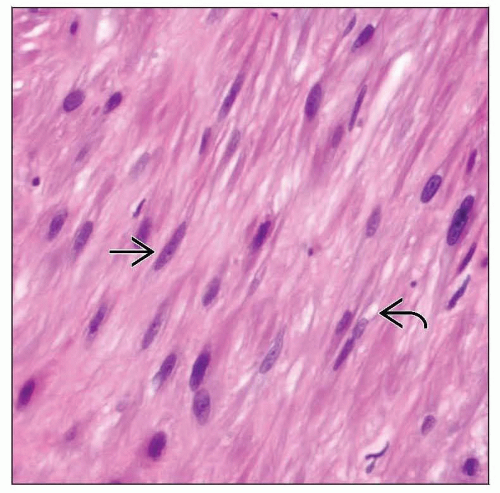Leiomyoma & Smooth Muscle Tumors of Uncertain Malignant Potential
Bruce M. Wenig, MD
Key Facts
Clinical Issues
Benign tumor of smooth muscle
One of least common mesenchymal tumors in head and neck mucosal sites
Presentation includes painless mass, nasal obstruction
Thought to originate from smooth muscle within vascular structures (vascular leiomyoma)
Macroscopic Features
On cut section, appears homogeneous with whorled appearance
Microscopic Pathology
Interlacing bundles or fascicles of cells
Blunt-ended or cigar-shaped nuclei, abundant eosinophilic cytoplasm
Cellular leiomyoma
Increase in cells but lacking significant pleomorphism, mitotic activity, necrosis
Smooth muscle tumor of uncertain malignant potential
Similar clinical features to leiomyoma
Increased cellularity
Moderate nuclear pleomorphism
Presence of no more than 4 mitoses per 10 HPF
Locally infiltrative growth may occur
Ancillary Tests
Actins, vimentin, desmin positive
Top Differential Diagnoses
Benign peripheral nerve sheath tumor, solitary fibrous tumor, leiomyosarcoma
TERMINOLOGY
Abbreviations
Smooth muscle tumor of uncertain malignant potential (SMTUMP)
Synonyms
Vascular leiomyoma
Definitions
Benign tumor of smooth muscle
ETIOLOGY/PATHOGENESIS
Idiopathic
No known etiologic factors
CLINICAL ISSUES
Epidemiology
Incidence
One of least common mesenchymal tumors in head and neck mucosal sites
Relative paucity of smooth muscle in region other than related to blood vessels
Thought to originate from smooth muscle within vascular structures (vascular leiomyoma)
Age
All ages but generally tumor of adult life
Peak incidence in 6th decade
Gender
Male > Female
Site
Most common sites of occurrence in head and neck include
Skin
Oral cavity (lips, tongue, and palate)
Stay updated, free articles. Join our Telegram channel

Full access? Get Clinical Tree







